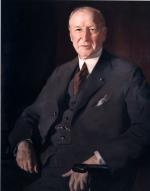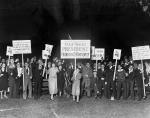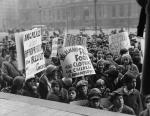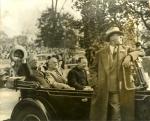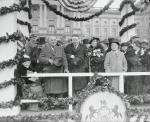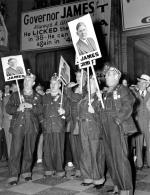Chapter 2: Political Change and the New Deal Coalition
When the New York Stock Market crashed in October, 1929, Republicans had ruled the state of Pennsylvania for more than sixty years. Between the Civil War and the outbreak of the Depression, Democrats reached the governor's office just twice, the last time in 1882. Republicans also held firm control of both the upper and lower houses in the Pennsylvania General Assembly, as well as most of the state's cities, thanks in large measure to the lucrative patronage systems of the urban political machines. In Philadelphia, the Democratic Party was so thoroughly dominated by the Republicans that city GOP leader William Vare even paid for the rent on its headquarters.
The onset of the Great Depression and failure of Republicans both in the state and in Washington D.C. to restore prosperity led to the election of Democrat Franklin Delano Roosevelt as president in 1932. After becoming president, FDR initiated a "New Deal" for Americans, pouring millions of dollars into work relief programs, regulating the stock market and banking industry, passing legislation that for the first time guaranteed workers the right to unionize and collective bargaining, and creating a national system of Social Security. Nationwide, a diverse group of voters representing organized labor, ethnic and racial minorities, political liberals, southern whites, and other groups supported Franklin Roosevelt's program for relief and reform.
Initially, it appeared as though the crisis would have little impact on politics in Pennsylvania. During the first months of the Depression, Governor John Fisher, a pro-business Republican from western Pennsylvania, proved a capable enough leader. Indeed, his commitment to highway construction and a public building program had earned him the nickname of "the builder," and helped to fortify state employment levels in 1930.
John Fisher, a pro-business Republican from western Pennsylvania, proved a capable enough leader. Indeed, his commitment to highway construction and a public building program had earned him the nickname of "the builder," and helped to fortify state employment levels in 1930.
But Fisher and the Republican-controlled General Assembly deviated little from the policies of previous Republican administrations, and their inadequate responses to the crisis created the opportunity for Gifford Pinchot to reclaim the governor's office to Harrisburg. Smelling "the beginnings of a new Progressive movement," Pinchot in 1930 won the Republican primary and general election, and once inaugurated as governor immediately launched an aggressive campaign to reform public utilities and lobby president Herbert Hoover - and later Roosevelt - for more direct relief.
Gifford Pinchot to reclaim the governor's office to Harrisburg. Smelling "the beginnings of a new Progressive movement," Pinchot in 1930 won the Republican primary and general election, and once inaugurated as governor immediately launched an aggressive campaign to reform public utilities and lobby president Herbert Hoover - and later Roosevelt - for more direct relief.
During the Presidential election of 1932, Pennsylvania was one of only six states to vote for incumbent Herbert Hoover. More than one million Pennsylvanians, however, voted Democrat for the first time in state history and 40 percent of the state's counties moved into the Democratic column.
The state Democratic Party also began to show signs of life. After Franklin Delano Roosevelt's election, Pennsylvania Senator Joseph Guffey, whose support of Roosevelt at the Democratic presidential had helped insure FDR the nomination, became the undisputed leader of the state Democratic Party. Guffey now controlled the patronage that came with the tens of millions of dollars of federal relief money that poured into the state. The weakening of the state GOP made room for a new breed of state Democrats, including South Philadelphia's Anne Brancato, who in 1932 became the first female Democrat ever elected to the state General Assembly, and Pittsburgh's
Anne Brancato, who in 1932 became the first female Democrat ever elected to the state General Assembly, and Pittsburgh's  David Lawrence, who in 1934 became Democratic State Chairman.
David Lawrence, who in 1934 became Democratic State Chairman.
The collapse of the American free market system and failure of either party to quickly end the Great Depression also fueled the rise of third-party movements ranging from the American Communist Party to the American Nazi Bund. In the 1932 presidential election, Norman Thomas, with Reading, PA's James Maurer as his running mate, won almost 885,000 votes, up from 267,000 in 1928.
James Maurer as his running mate, won almost 885,000 votes, up from 267,000 in 1928.
A stronghold of American socialism, the city of Reading elected Socialist Darlington Hoopes to three terms in the Pennsylvania assembly from 1930 to 1936. Pennsylvania members of the American Communist Party, although always small in number, organized in the coal fields, steel mills, and other industries, and staged marches and demonstrations that drew thousands of spectators and swift, at times violent police response. Later in the decade, fascism also had its appeal, especially among Italian Americans in Philadelphia and ethnic Germans drawn to the American Bund.
These remained marginal, though at times influential movements. During the Great Depression, the overwhelming majority of Pennsylvanians sought solutions within the two party system. Roosevelt's strong support for the rights of organized labor brought industrial workers, who had customarily voted Republican, to the Democratic Party, beginning an alliance that would continue to the present.
Ethnic voters were likewise won over to the Democratic Party. Their flirtation had begun with the 1928 Presidential election, when many Catholic voters in Pittsburgh and Philadelphia abandoned Hoover for New York Governor Al Smith, the Democratic - and Catholic -candidate. Roosevelt's New Deal policies of relief and reform consummated the relationship and completed the realignment.
African Americans voters, too, made the leap to the Democratic Party. Since the Civil War, blacks had reliably voted Republican, both because of residual loyalty for the party that had led the war against slavery and because the Democratic Party had never offered a viable alternative. For decades, however, the Republicans had done little for African Americans.
In 1932, emerging black leaders in Pennsylvania organized for Roosevelt, including Pittsburgh newspaper publisher Robert Lee Vann who urged his fellow African Americans to
Robert Lee Vann who urged his fellow African Americans to  "turn Lincoln's portrait to the wall" and support Roosevelt's Democratic Party. In Pittsburgh, black voters did just that, supporting FDR's candidacy in 1932. In Philadelphia, too, a new generation of African American leaders including
"turn Lincoln's portrait to the wall" and support Roosevelt's Democratic Party. In Pittsburgh, black voters did just that, supporting FDR's candidacy in 1932. In Philadelphia, too, a new generation of African American leaders including  Raymond Pace and Sadie T. M. Alexander and Robert N. C., Nix mobilized against racial discrimination and the Republican city machine. By the end of the decade Philadelphia's black community also had joined the New Deal coalition. In 1939, they elected
Raymond Pace and Sadie T. M. Alexander and Robert N. C., Nix mobilized against racial discrimination and the Republican city machine. By the end of the decade Philadelphia's black community also had joined the New Deal coalition. In 1939, they elected  Crystal Bird Fauset to the state legislature, the first African-American woman to hold a state office. The break took more time in Philadelphia, but by the end of the decade Philadelphia's black community also had joined the New Deal coalition.
Crystal Bird Fauset to the state legislature, the first African-American woman to hold a state office. The break took more time in Philadelphia, but by the end of the decade Philadelphia's black community also had joined the New Deal coalition.
In the mid-1930s, Pennsylvania's newly mobilized Democratic electorate began to turn the tide in political contests across the state. In 1934 Democrats won control of the General Assembly and the Governorship, and captured the mayor's office in Pittsburgh. In January 1935, George H. Earle III became the first Democrat in more than forty years to take the oath of office as Pennsylvania governor.
George H. Earle III became the first Democrat in more than forty years to take the oath of office as Pennsylvania governor.
For the next two years the Republican majority in the Senate was able to block passage of most Democrat-sponsored legislation. But after voters in 1936 gave the Democrats an unprecedented two-thirds majority in the upper chamber, the Earle administration unleashed its own "Little New Deal," a series of laws and programs designed to under gird the national program for relief and reform that remains the most prolific outpouring of legislation in state history.
Using New Deal relief money to help create its own army of party workers, the Democrats, however, took too much, too quickly. And the Republicans soon struck back. In the early years of the Great Depression the state Republican Party had fallen apart. After the collapse of the Mellon organization in Pittsburgh and Vare machine in Philadelphia, leadership of the party had gone to lobbyist Joseph Grundy, founder of the Pennsylvania Manufacturers Association (PMA).
Joseph Grundy, founder of the Pennsylvania Manufacturers Association (PMA).
During the 1930s, the PMA led the attack against the New Deal, blasting the Democrats for prolonging the Great Depression by attacking business and misspending public funds rather than creating the conditions for the free market to correct itself. In Philadelphia, Joseph Pew used his personal wealth as vice president of the Sun Oil Company to take control of the Republican Party there and to help fund a national public relations campaign against Roosevelt before the 1936 presidential election.
In 1937, a renewed recession gave Republican arguments new credence. Then, as the 1938 election approached, State Attorney General Charles Margiotti unleashed an investigation of widespread corruption among Democratic Party leaders, who were using federal relief funds for patronage, and Democratic leaders squabbled over who to select as Earle's successor as governor. Backed by Joe Pew, Republican gubernatorial candidate Arthur Horace James ran a smooth campaign, vowing to undo the "Little New Deal," cut taxes, and improve the climate for business.
Arthur Horace James ran a smooth campaign, vowing to undo the "Little New Deal," cut taxes, and improve the climate for business.
In November, the Republican Party steamrolled back into power, regaining control of the Governor's office, both houses of the state legislature, a majority of the state congressional seats, and both seats in the United States Senate. Backed by Governor James, the state legislature quickly repealed some of the Little New Deal legislation, but most remained intact, for the Commonwealth was still dependent upon federal relief funding. And in fundamental ways, the Great Depression and spirit of the New Deal had permanently altered Pennsylvania's political culture.
During the late 1930s, the Democratic Party solidified its presence at nearly every level of government, from local to state to national. Pennsylvania delivered clear majorities for Roosevelt in 1936 and again in 1940. By then Pennsylvania had experienced a political realignment that has continued to the present day.
The onset of the Great Depression and failure of Republicans both in the state and in Washington D.C. to restore prosperity led to the election of Democrat Franklin Delano Roosevelt as president in 1932. After becoming president, FDR initiated a "New Deal" for Americans, pouring millions of dollars into work relief programs, regulating the stock market and banking industry, passing legislation that for the first time guaranteed workers the right to unionize and collective bargaining, and creating a national system of Social Security. Nationwide, a diverse group of voters representing organized labor, ethnic and racial minorities, political liberals, southern whites, and other groups supported Franklin Roosevelt's program for relief and reform.
Initially, it appeared as though the crisis would have little impact on politics in Pennsylvania. During the first months of the Depression, Governor
But Fisher and the Republican-controlled General Assembly deviated little from the policies of previous Republican administrations, and their inadequate responses to the crisis created the opportunity for
During the Presidential election of 1932, Pennsylvania was one of only six states to vote for incumbent Herbert Hoover. More than one million Pennsylvanians, however, voted Democrat for the first time in state history and 40 percent of the state's counties moved into the Democratic column.
The state Democratic Party also began to show signs of life. After Franklin Delano Roosevelt's election, Pennsylvania Senator Joseph Guffey, whose support of Roosevelt at the Democratic presidential had helped insure FDR the nomination, became the undisputed leader of the state Democratic Party. Guffey now controlled the patronage that came with the tens of millions of dollars of federal relief money that poured into the state. The weakening of the state GOP made room for a new breed of state Democrats, including South Philadelphia's
The collapse of the American free market system and failure of either party to quickly end the Great Depression also fueled the rise of third-party movements ranging from the American Communist Party to the American Nazi Bund. In the 1932 presidential election, Norman Thomas, with Reading, PA's
A stronghold of American socialism, the city of Reading elected Socialist Darlington Hoopes to three terms in the Pennsylvania assembly from 1930 to 1936. Pennsylvania members of the American Communist Party, although always small in number, organized in the coal fields, steel mills, and other industries, and staged marches and demonstrations that drew thousands of spectators and swift, at times violent police response. Later in the decade, fascism also had its appeal, especially among Italian Americans in Philadelphia and ethnic Germans drawn to the American Bund.
These remained marginal, though at times influential movements. During the Great Depression, the overwhelming majority of Pennsylvanians sought solutions within the two party system. Roosevelt's strong support for the rights of organized labor brought industrial workers, who had customarily voted Republican, to the Democratic Party, beginning an alliance that would continue to the present.
Ethnic voters were likewise won over to the Democratic Party. Their flirtation had begun with the 1928 Presidential election, when many Catholic voters in Pittsburgh and Philadelphia abandoned Hoover for New York Governor Al Smith, the Democratic - and Catholic -candidate. Roosevelt's New Deal policies of relief and reform consummated the relationship and completed the realignment.
African Americans voters, too, made the leap to the Democratic Party. Since the Civil War, blacks had reliably voted Republican, both because of residual loyalty for the party that had led the war against slavery and because the Democratic Party had never offered a viable alternative. For decades, however, the Republicans had done little for African Americans.
In 1932, emerging black leaders in Pennsylvania organized for Roosevelt, including Pittsburgh newspaper publisher
In the mid-1930s, Pennsylvania's newly mobilized Democratic electorate began to turn the tide in political contests across the state. In 1934 Democrats won control of the General Assembly and the Governorship, and captured the mayor's office in Pittsburgh. In January 1935,
For the next two years the Republican majority in the Senate was able to block passage of most Democrat-sponsored legislation. But after voters in 1936 gave the Democrats an unprecedented two-thirds majority in the upper chamber, the Earle administration unleashed its own "Little New Deal," a series of laws and programs designed to under gird the national program for relief and reform that remains the most prolific outpouring of legislation in state history.
Using New Deal relief money to help create its own army of party workers, the Democrats, however, took too much, too quickly. And the Republicans soon struck back. In the early years of the Great Depression the state Republican Party had fallen apart. After the collapse of the Mellon organization in Pittsburgh and Vare machine in Philadelphia, leadership of the party had gone to lobbyist
During the 1930s, the PMA led the attack against the New Deal, blasting the Democrats for prolonging the Great Depression by attacking business and misspending public funds rather than creating the conditions for the free market to correct itself. In Philadelphia, Joseph Pew used his personal wealth as vice president of the Sun Oil Company to take control of the Republican Party there and to help fund a national public relations campaign against Roosevelt before the 1936 presidential election.
In 1937, a renewed recession gave Republican arguments new credence. Then, as the 1938 election approached, State Attorney General Charles Margiotti unleashed an investigation of widespread corruption among Democratic Party leaders, who were using federal relief funds for patronage, and Democratic leaders squabbled over who to select as Earle's successor as governor. Backed by Joe Pew, Republican gubernatorial candidate
In November, the Republican Party steamrolled back into power, regaining control of the Governor's office, both houses of the state legislature, a majority of the state congressional seats, and both seats in the United States Senate. Backed by Governor James, the state legislature quickly repealed some of the Little New Deal legislation, but most remained intact, for the Commonwealth was still dependent upon federal relief funding. And in fundamental ways, the Great Depression and spirit of the New Deal had permanently altered Pennsylvania's political culture.
During the late 1930s, the Democratic Party solidified its presence at nearly every level of government, from local to state to national. Pennsylvania delivered clear majorities for Roosevelt in 1936 and again in 1940. By then Pennsylvania had experienced a political realignment that has continued to the present day.






